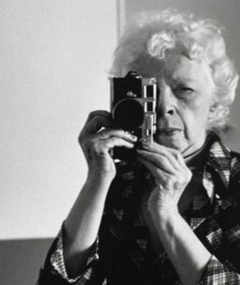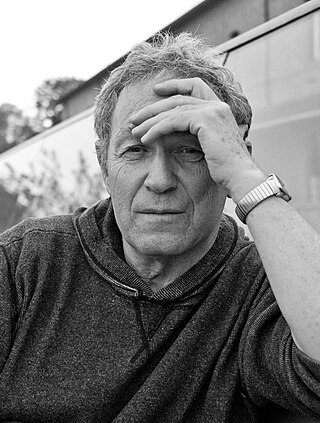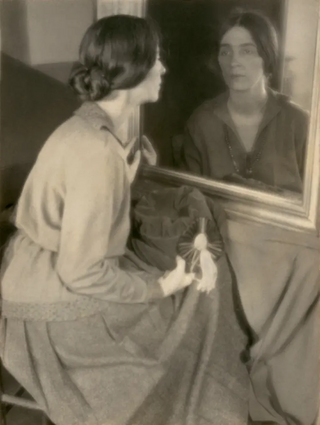George Platt Lynes was an American fashion and commercial photographer who worked in the 1930s and 1940s. He produced photographs featuring many gay artists and writers from the 1940s that were acquired by the Kinsey Institute after his death in 1955.

Melvin Ormond Hammond, known professionally as M. O. Hammond, was a Canadian journalist, photographer, and author.

Michael Arthur Worden Evans was an American newspaper, magazine, and presidential photographer. He was Ronald Reagan's personal photographer during his first term as president from 1981 through 1985. Evans is best remembered for his 1976 iconic photo of Ronald Reagan wearing a cowboy hat taken while Evans was working for Equus Magazine, that made the covers of many magazines in the week after Reagan's death in 2004. He was nominated for Pulitzer Prize while shooting for The New York Times.

Albert Watson OBE is a Scottish fashion, celebrity and art photographer. He has shot over 100 covers of Vogue and 40 covers of Rolling Stone magazine since the mid-1970s, and has created major advertising campaigns for clients such as Prada, Chanel and Levis. Watson has also taken some well-known photographs, from the portrait of Steve Jobs that appeared on the cover of his biography, a photo of Alfred Hitchcock holding a plucked goose, and a portrait of a nude Kate Moss taken on her 19th birthday.

Lisette Model was an Austrian-born American photographer primarily known for the frank humanism of her street photography.
Larry Towell is a Canadian photographer, poet, and oral historian. Towell is known for his photographs of sites of political conflict in the Ukraine, Nicaragua, El Salvador, Standing Rock and Afghanistan, among others. In 1988, Towell became the first Canadian member of Magnum Photos.
Walter Chin is a fashion and celebrity photographer of Chinese descent who currently lives and works in New York City, U.S.

Marc Atkins is an English artist, photographer, filmmaker and poet, born in 1962, best known for his photography of cities and nudes, also commercially for music album and book covers.

Frank Eugene was an American-born photographer who was a founding member of the Photo-Secession and one of the first university-level professors of photography in the world.

Yuri Dojc is a Slovak-Canadian fine arts photographer. Dojc currently resides in Toronto, Canada, with work internationally exhibited in countries such as Brazil, Slovakia, Rwanda as well as across Canada.

Photography by indigenous peoples of the Americas is an art form that began in the late 19th century and has expanded in the 21st century, including digital photography, underwater photography, and a wide range of alternative processes. Indigenous peoples of the Americas have used photography as a means of expressing their lives and communities from their own perspectives. Native photography stands in contrast to the ubiquitous photography of indigenous peoples by non-natives, which has often been criticized as being staged, exoticized, and romanticized.
Simon Harsent is a fine art and commercial photographer. The eldest son of British poet David Harsent, he was born in Aylesbury, England in 1965, and lives in New York and Australia. Harsent's work has been exhibited in galleries and museums worldwide.
Samuel Bejan Tata was a Chinese photographer and photojournalist of Parsi descent. Tata grew up in Shanghai where he learned the basics of photography from several mentors including Lang Jingshan and Liu Xucang. Due to political unrest, he mostly confined himself in his early career to portraiture in the tradition of pictorialism. In 1946, he moved to India for two years where he took up photography full-time. A friendship begun in Bombay with the French photographer Henri Cartier-Bresson transformed his approach, with an emphasis towards street photography and a more natural style in his portraits. Tata returned to Shanghai and photographed, for some months accompanied by Cartier-Bresson, the occupation of the city by the new Communist regime. Starting in the 1950s, Tata engaged in assignments for prominent magazines such as National Geographic. Via Hong Kong and India, Tata emigrated to Montreal in 1956, where he created documentary stills for the National Film Board and continued photography for various publications. He became known for his portraits of Canadian artists and authors. Tata's work has been the subject of books and touring exhibitions, and his photographs are found in several institutions, including the National Gallery of Canada.

Margaret Watkins (1884–1969) was a Canadian photographer who is remembered for her innovative contributions to advertising photography. She lived a life of rebellion, rejection of tradition, and individual heroism; she never married, she was a successful career woman in a time when women stayed at home, and she exhibited eroticism and feminism in her art and writing.

Robert Farber is an American photographer and lecturer known for his work with nudes, fashion, landscapes and still lives. He has published eleven books of original collections that have sold over half-a-million copies, four of them revised into later editions. He continues to exhibit classic and new work worldwide.
Martin Hugo Maximilian Schreiber is a Czech-American photographer. He is best known for his photographs of women, particularly a nude shot of Madonna taken in 1979.
Demetrius Fordham is an American portrait photographer and author. He is known for his work exploring the themes, including human identity, discrimination inequality, sustainability and the natural world.
Gordon Webber was a multimedia pioneer of modernism in Canada. He was also an educator.

John Wentworth Russell was a Canadian painter with a wide range of subjects and media – portraits, landscapes, still life, and the nude as well as illustrations for magazines, such as Vogue. Russell’s large painting A Modern Fantasy, of a reclining female nude echoing Titian but realistically depicted and wearing a hat, caused a sensation when shown at the Canadian National Exhibition (C.N.E.) in Toronto in 1927. Although many adverse comments were published, Prime Minister Mackenzie King stated of the work: "1 saw the painting at the Ex and thought it a marvelous work.











